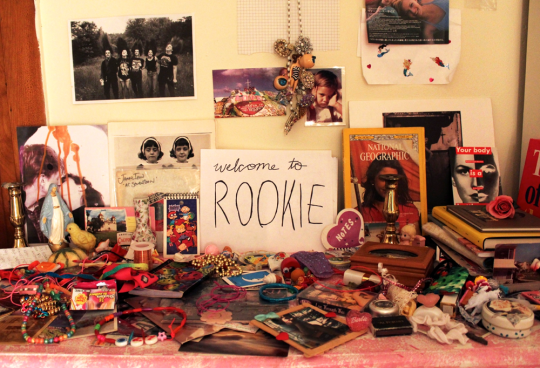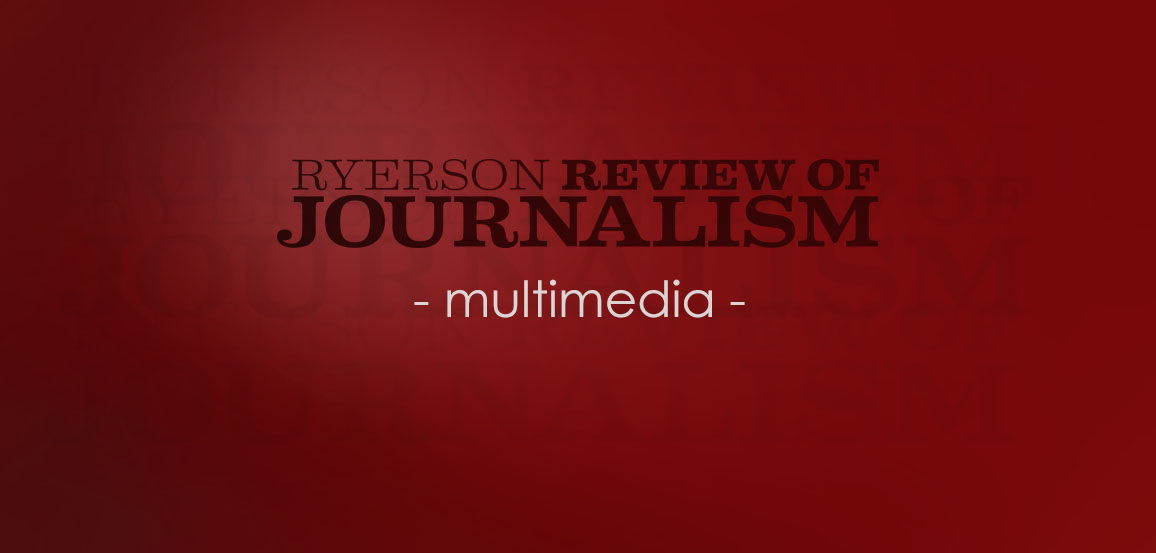 On teen website RookieMag.com, today’s background is a photo of Winona Ryder in Edward Scissorhands, and the title of this month’s theme, “Obsession,” is handwritten in red crayon at the top of the page. “Literally the Best Thing Ever: Degrassi” and “How to Approach the Person You Like Without Throwing Up” are typical headlines. Yesterday’s posts are perched at the top of the page—it’s 2 p.m. and the first post of the day won’t go live until after school, followed by two more, at dinner time and before bed.
On teen website RookieMag.com, today’s background is a photo of Winona Ryder in Edward Scissorhands, and the title of this month’s theme, “Obsession,” is handwritten in red crayon at the top of the page. “Literally the Best Thing Ever: Degrassi” and “How to Approach the Person You Like Without Throwing Up” are typical headlines. Yesterday’s posts are perched at the top of the page—it’s 2 p.m. and the first post of the day won’t go live until after school, followed by two more, at dinner time and before bed.
After school? The timing makes sense when you know that the editor-in-chief of this ambitious site, Tavi Gevinson, is 15 years old. Rookie got its start almost two years ago, when Gevinson announced on her blog, “I have a bit of a request, my dear friends. I, like many, would like another Sassy magazine.” Jane Pratt, former editor of the iconic title, heard her plea, and the pair decided to start a new magazine for teenage girls. “Of course, it won’t be Sassy (or the rebirth of Sassy, or Sassy 2.0) and nor do we want it to be,” explained Gevinson at the time. “For one, you can’t try to recreate something that good. For another… this world calls for something different. Something that will use Sassy as a point of reference for the whole teen-magazine-that-doesn’t-suck thing.”
By September 2011, Gevinson had split from Pratt—no hard feelings, she just wanted editorial independence—and launched Rookie, a self-proclaimed “place to make the best of the beautiful pain and cringe-worthy awkwardness of being an adolescent girl.” As Gevinson’s first editor’s letter said, the magazine would be neither a “guide to Being a Teen” nor “a pamphlet on How to Be a Young Woman.”Instead, it began as a refreshing antidote to the countless teen-girl publications that treat their readers like mindless consumers always in need of self-improvement.
Six months after launching, how effectively is Rookie fulfilling its mandate?
I directed a close friend’s sister, who was 14 at the time, to Rookie the day it launched. I knew she read Toronto’s feminist teen magazine, Shameless, and that she occasionally checked Gevinson’s fashion blog, Style Rookie. The new online magazine quickly became Ellie Ellwand’s homepage. “I love that it’s like the polar opposite of Seventeen,” she told me. “Instead of telling you how to be, it just gives you tips on how to deal with this crazy period of adolescence. I think for girls, now, that’s the best thing.”
“What Rookie does really well is it doesn’t try to censor information that girls need to hear,” says Anna Fitzpatrick, my colleague at Worn Fashion Journal and a Rookie contributor. Rookie’s writers are frank and honest when discussing things like sex, mental health, and drug use. “That’s not to say that this information isn’t available elsewhere,” says Fitzpatrick, “but I think a lot of teen girls might be more comfortable reading a magazine or an online magazine and hearing this than going to a counsellor or some other place that might have stigma attached.” Rookie is something of a “no-fear zone,” where you can read a celebrity interview or fashion tips in the same context as more taboo subjects that are often watered down or sugarcoated in mainstream media sources.
Molly Fischer wrote in n+1 magazine that Rookie is perhaps more suited to nostalgic adults than to teenagers, who spend a lot of their time “imagining what life will be like when one is no longer a teenage girl.” Fischer writes, “The idea of being an adult is totally fascinating to teenagers. The idea of being a teenager is interesting primarily to preadolescents and adults.” Ellwand would have to disagree. While she admits to “dreaming about the future, always,” she also thinks teenagers are self-absorbed. “It’s fun to have our own thoughts and worries translated into entertainment,” she says. One article Ellwand especially liked is called “How Not to Care What Other People Think of You.” In the article, Gevinson addresses the “depressing number” of reader-submitted questions Rookie has received about low self-esteem and how to overcome it. “It identified with so many of the things that I think about all the time,” says Ellwand. “Sometimes I don’t know how to articulate those feelings.”
Fischer’s n+1 article also posits that “[Gevinson’s] vocabulary, which includes My So-Called Life, Daria, Clueless, and, of course, Sassy, belongs to an adult cohort that came of age in the nineties.” Ellwand, a Grade 10 student at Etobicoke School of the Arts, says it’s true that many of the pop culture references on Rookie are lost on her, but that doesn’t stop her from reading the site daily. What matters to Ellwand is the way Rookie treats its readers. Unlike so many other teen magazines, it doesn’t categorize or stereotype young women, and it doesn’t treat them like empty heads with dollar signs for eyeballs.
Since its launch, Rookie has developed an advertising agreement with New York Media, the owner of New York magazine, but advertising on the site has remained minimal. “One of many benefits of being online is that we don’t rely so heavily on advertisers, and we don’t feel pressured to push certain products,” says Gevinson. “We have ads for beauty and fashion, but we don’t have to do these cheesy, stupid giveaways, and we don’t feel any need to write a bunch of articles about all the different ways that you need makeup.” Beauty and fashion are covered in Rookie, but as forms of self-expression rather than as tools for self-improvement. “I think that’s my biggest problem with so much of what’s aimed at teenage girls—and women, but I think it’s more dangerous when your self-esteem is still developing—is that it’s like there’s always something on the to-do list,” Gevinson says. “There will always be something wrong with you.”
Despite sincere attempts to throw off the beauty ideals portrayed in so many female-centric publications, Gevinson has found it difficult to present a more diverse image in Rookie’s photo shoots. “I don’t want to make excuses,” she says, “but when we started, we didn’t realize how involved we (me and Anaheed [Alani, Rookie’s story editor and editorial director]) would have to be in just about everything. So we would be like, ‘Yeah, of course, shoot your friends.’ Not everyone grows up in, like, the United Colors of Benetton—a girl justends up taking pictures of her sister and her friends, and they all happen to be white and skinny. So, now we’re more involved in casting.”
Spencer Tweedy, who contributes to Rookie’s “About a Boy” column, says that although the site’s tagline claims it’s for girls, he doesn’t see it as exclusively so. “Almost everything can just be applied to thoughtful teens that want something more out of a teen publication,” says Tweedy, who has been blogging on his own since he was 12. “I think [the teen media industry] is not really a culture that honours or at least encourages kids to be expressive with their feelings, for better or worse.”
Despite Gevinson’s early insistence that Rookie isn’t Sassy 2.0, Marisa Meltzer, co-author of How Sassy Changed My Life, sees it as an heir to the much-loved and missed teen magazine that had its heyday in the ’90s. “I think Rookie has had more freedom than Sassy had,” says Meltzer, mentioning problems Sassy had with advertisers, boycotts, and Focus on the Family. “And Rookie so far seems to be able to do its thing without any big problems,” she says. “There’s something about a print magazine that can be bought by parents in a drugstore that makes it more liable to being a source of outrage.” Meltzer applauds Rookie’s honesty, its mix of serious and fun content, its do it yourself projects, and its encouragement of reader involvement. “In some ways [Rookie is] better than Sassy was, because there’s no leash.”
About the author
Stephanie Fereiro was the Chief Copy Editor of the Summer 2012 issue of the Ryerson Review of Journalism.


